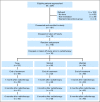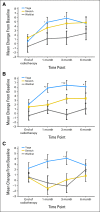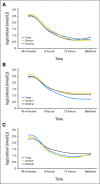Randomized, controlled trial of yoga in women with breast cancer undergoing radiotherapy
- PMID: 24590636
- PMCID: PMC3965260
- DOI: 10.1200/JCO.2012.48.2752
Randomized, controlled trial of yoga in women with breast cancer undergoing radiotherapy
Abstract
Purpose: Previous research incorporating yoga (YG) into radiotherapy (XRT) for women with breast cancer finds improved quality of life (QOL). However, shortcomings in this research limit the findings.
Patients and methods: Patients with stages 0 to III breast cancer were recruited before starting XRT and were randomly assigned to YG (n = 53) or stretching (ST; n = 56) three times a week for 6 weeks during XRT or waitlist (WL; n = 54) control. Self-report measures of QOL (Medical Outcomes Study 36-item short-form survey; primary outcomes), fatigue, depression, and sleep quality, and five saliva samples per day for 3 consecutive days were collected at baseline, end of treatment, and 1, 3, and 6 months later.
Results: The YG group had significantly greater increases in physical component scale scores compared with the WL group at 1 and 3 months after XRT (P = .01 and P = .01). At 1, 3, and 6 months, the YG group had greater increases in physical functioning compared with both ST and WL groups (P < .05), with ST and WL differences at only 3 months (P < .02). The group differences were similar for general health reports. By the end of XRT, the YG and ST groups also had a reduction in fatigue (P < .05). There were no group differences for mental health and sleep quality. Cortisol slope was steepest for the YG group compared with the ST and WL groups at the end (P = .023 and P = .008) and 1 month after XRT (P = .05 and P = .04).
Conclusion: YG improved QOL and physiological changes associated with XRT beyond the benefits of simple ST exercises, and these benefits appear to have long-term durability.
Conflict of interest statement
Authors' disclosures of potential conflicts of interest and author contributions are found at the end of this article.
Figures




References
-
- Irvine D, Brown B, Crooks D, et al. Psychosocial adjustment in women with breast cancer. Cancer. 1991;67:1097–1117. - PubMed
-
- Ganz PA, Lee JJ, Sim MS, et al. Exploring the influence of multiple variables on the relationship of age to quality of life in women with breast cancer. J Clin Epidemiol. 1992;45:473–485. - PubMed
-
- Ulger O, Yagli NV. Effects of yoga on the quality of life in cancer patients. Complement Ther Clin Pract. 2010;16:60–63. - PubMed
Publication types
MeSH terms
Substances
Grants and funding
LinkOut - more resources
Full Text Sources
Other Literature Sources
Medical

